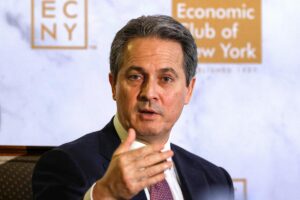Economic Outlook Amidst Trade Tensions: Insights from St. Louis Fed President
In a recent address, Alberto Musalem, the President of the St. Louis Federal Reserve, shed light on the potential ramifications of ongoing trade tensions between the U.S. and China, emphasizing that the current tariffs could significantly affect the economy in the immediate term. Despite a temporary truce on tariffs negotiated by President Trump, Musalem noted that we should brace for potential slowdowns in economic growth, job availability, and increased consumer prices.
Musalem’s remarks, shared during a speech in Minneapolis, reveal a complex and uncertain economic landscape. He pointed out that while the Federal Reserve’s monetary policy appears well-equipped to navigate these shifts, the "current range of possible economic outcomes is unusually wide." This uncertainty underscores the challenges ahead as policymakers grapple with the implications of fluctuating trade policies, immigration, deregulation, and tax strategy.
The Impact of Tariffs on Economic Activity
According to Musalem, the existing tariffs—currently set at 10% for many nations—are projected to dampen economic activity and could lead to a further softening of the labor market. The effects of tariffs on imported goods not only cause immediate price increases but can also ripple through the economy, influencing domestically produced goods and potentially igniting inflationary pressures.
The Fed has been keenly aware of the broader implications of these trade policies. Many policymakers have expressed concerns about rising inflation and job stagnation, attributing these challenges to ongoing tariff negotiations. Although the U.S. and China agreed to reduce their tariffs for a 90-day window, Musalem urges caution, suggesting that these changes may not sufficiently mitigate the tariffs’ impact on the economy.
Navigating Economic Uncertainty
One of the pivotal questions currently facing central bank officials is whether the anticipated rise in prices stemming from these trade policies will be a short-lived phenomenon. The White House argues that any inflationary pressure should be viewed as a temporary adjustment. However, many Fed officials remain skeptical, leading to a delicate balancing act between maintaining stable prices and maximizing employment.
Fed Chair Jerome Powell reinforced this sentiment during a recent press conference, indicating that greater clarity is needed regarding the long-term effects of tariffs before definitive monetary policy decisions can be made.
Possible Scenarios for Inflation and Monetary Policy
As Musalem outlines, there are two primary scenarios that could unfold regarding inflation. In the first scenario, if tariffs have only a minimal and brief effect on prices, the Fed may consider easing monetary policy to counteract potential job losses. However, he cautioned against underestimating the dynamics of inflation, which could prove costly if not adequately addressed.
Conversely, should inflation persist, the emphasis would shift towards ensuring price stability. Musalem noted that history shows that restoring stability is far more burdensome for the economy if inflation expectations are not managed effectively. As he aptly states, "policy should prioritize price stability in the face of persistent inflationary pressures."
The Path Forward
Musalem urged the necessity of public confidence in the Fed’s commitment to combating inflation. He proposed that should trade negotiations lead to lasting reductions in tariffs and a stabilization of global trade flows, the economy might revert to its prior trajectory, complete with a resilient job market and a return of inflation to the target rate of 2%.
Despite indications of declining sentiment among consumers and businesses, Musalem affirms that the U.S. economy showcases underlying strength. This resilience could be critical as we navigate the forthcoming months of economic unpredictability.
At Extreme Investor Network, we’ll continue monitoring these developments closely. Stay tuned for deeper analysis on how global events, trade dynamics, and monetary policy could influence your investments and the broader economy.

